Vellum Bloom
Transmission & Vectors
Timeline:
- Incubation: 3–5 days post-consumption
- Onset: Gradual physical changes within 1 week
- Chronic Phase: Indefinite progression unless treated
- Dormancy: Parasites may remain asymptomatic for years, reactivating due to immune stress or exposure to encoded stimuli (e.g., specific texts, frequencies, chemical signatures)
Type
Nanite / Mechanical
Origin
Engineered
Cycle
Chronic, Acquired
Rarity
Rare
Affected Species








Comments